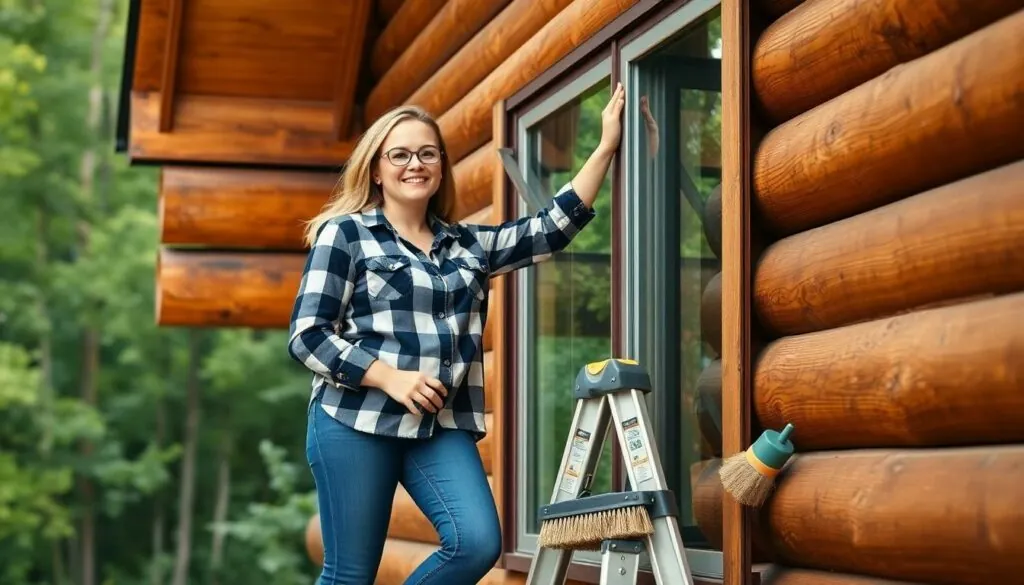Table of Contents
ToggleLog homes are the cozy retreats that make you feel like you’re living in a fairytale—until the maintenance fairy forgets to show up. Keeping those beautiful logs in tip-top shape isn’t just about aesthetics; it’s about protecting your investment and ensuring your home remains a sanctuary. But who wants to spend their weekends scrubbing, sealing, and battling the elements when there are more fun things to do?
Finding reliable log home maintenance near you can turn that daunting task into a breeze. Imagine professionals swooping in, armed with the right tools and expertise, while you kick back with a cup of coffee. With the right help, your log home can stay as charming as the day it was built, without the stress of DIY disasters. It’s time to give your logs the love they deserve and keep your home looking as enchanting as ever.
Understanding Log Home Maintenance
Log home maintenance plays a crucial role in preserving the beauty and value of these unique structures. Regular care enhances longevity and prevents costly repairs.
Importance of Regular Maintenance
Regular maintenance protects log homes from damage caused by weather, insects, and moisture. It minimizes the risk of rot and pest infestations, ensuring structural integrity. Neglecting upkeep can lead to significant repair costs over time. Homeowners benefit from addressing issues proactively, which simplifies long-term preservation. Maintaining aesthetics also contributes to property value. This upkeep allows homeowners to enjoy a beautiful living environment without the threat of decay.
Typical Maintenance Tasks
Common maintenance tasks include inspecting and sealing the exterior. Using the right stain or sealant helps prevent moisture buildup. Cleaning gutters regularly prevents water accumulation around the base of the home. Applying borate treatments protects against pests and rot. Checking caulking and chinking between logs maintains energy efficiency and prevents drafts. Annual inspections identify any potential issues early, allowing for timely solutions. Utilizing professional services for complex maintenance ensures high-quality care and extends the life of log homes.
Finding Local Log Home Maintenance Services

Homeowners can locate log home maintenance services by utilizing various online tools and community resources. Searching engines provide quick access to local professionals, and platforms like Yelp or Angie’s List offer reviews from other homeowners.
How to Search for Services Near You
Start by searching for “log home maintenance near me” in search engines. Geographic location plays a crucial role, so including your city or zip code enhances relevance. Ask friends or neighbors for recommendations, as they might have useful experiences. Engage in local social media groups dedicated to home improvements for referrals. Checking online reviews helps gauge service quality, while company websites often showcase customer testimonials and service details.
Evaluating Service Providers
Assess qualifications before hiring any service provider. Check for licenses and insurance, ensuring they follow local regulations and protect homeowners from potential damages. Request references from previous clients to gain insights into reliability and workmanship. Comparing quotes allows homeowners to understand market rates, while evaluating the scope of services ensures they meet specific needs. Communication skills also matter—providers should demonstrate responsiveness and professionalism throughout the interaction.
DIY Log Home Maintenance Tips
Homeowners can effectively maintain log homes with a few essential tools and some proactive measures. Staying ahead of maintenance tasks ensures that log homes remain attractive and durable.
Essential Tools and Supplies
Each homeowner should have specific tools for log home maintenance. A power washer effectively removes dirt and mildew from surfaces. Scrub brushes with stiff bristles help to clean rough areas. For sealing, use high-quality caulk and chinking materials to fill gaps. Borate-based treatments protect against insects and fungi. A moisture meter detects wood humidity levels, ensuring logs stay properly dried. Lastly, having a good ladder enables access to hard-to-reach areas for inspections and repairs.
Common Problems and Solutions
Homeowners often encounter several issues when maintaining log homes. Rotting wood commonly occurs due to prolonged moisture exposure. Treat it with a borate solution to prevent further decay. Insect infestations may also occur, requiring the application of pest control methods to eliminate pests effectively. Weathering can fade wood color, so regular stain application preserves the natural look. Gaps in caulking or chinking can lead to energy loss, necessitating periodic inspection and repair to maintain efficiency. Addressing these common problems promptly can ensure the longevity and beauty of log homes.
Cost of Log Home Maintenance
Understanding the costs associated with log home maintenance helps homeowners plan effectively. Multiple factors impact overall expenses, making it essential to consider them when budgeting.
Factors That Influence Costs
Material types significantly affect maintenance costs. For example, hardwood logs often require more extensive care than softwood options. Geographic location also plays a crucial role, as service prices vary by region. Labor rates differ; urban areas typically have higher rates than rural settings. The condition of the home influences expenses as well, with neglected homes requiring more extensive repairs. Seasonal factors can increase costs, particularly in regions with harsh winters that demand additional upkeep. Lastly, whether homeowners choose DIY projects or professional services determines the price point, with professionals providing expertise that minimizes long-term issues.
Budgeting for Maintenance
Creating a budget for log home maintenance is vital for homeowners. Regular upkeep generally ranges from 1% to 4% of the home’s value annually. Allocating funds for tasks like sealing, inspections, and cleaning ensures financial preparedness. Setting aside $500 to $2,500 yearly is a good guideline for many homeowners. Prioritizing annual inspections helps catch potential problems early, saving on more significant repairs later. Additionally, homeowners can track expenses and adjust their budget as needed. Using quotes from multiple service providers provides an effective way to compare costs. Budgeting adequately ensures homeowners maintain their log homes’ beauty and value over time.
Maintaining a log home is essential for preserving its charm and value. By prioritizing regular upkeep and seeking professional assistance when needed, homeowners can protect their investment while enjoying their living space.
Utilizing local maintenance services can simplify the process and ensure high-quality care. With the right tools and proactive measures, potential issues can be addressed before they escalate into costly repairs.
Homeowners should not underestimate the importance of a well-maintained log home. By staying diligent with maintenance tasks and budgeting appropriately, they can enjoy the beauty and longevity of their log homes for years to come.




